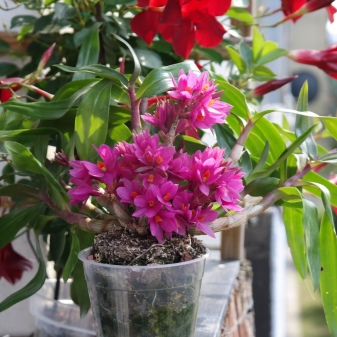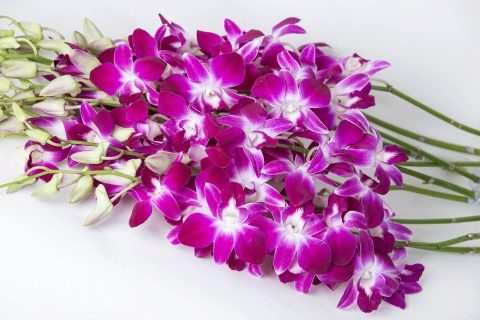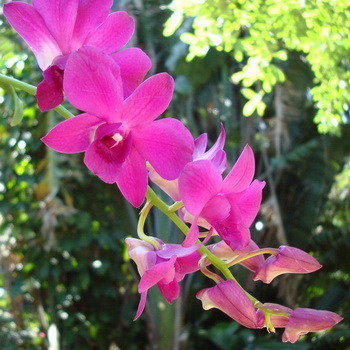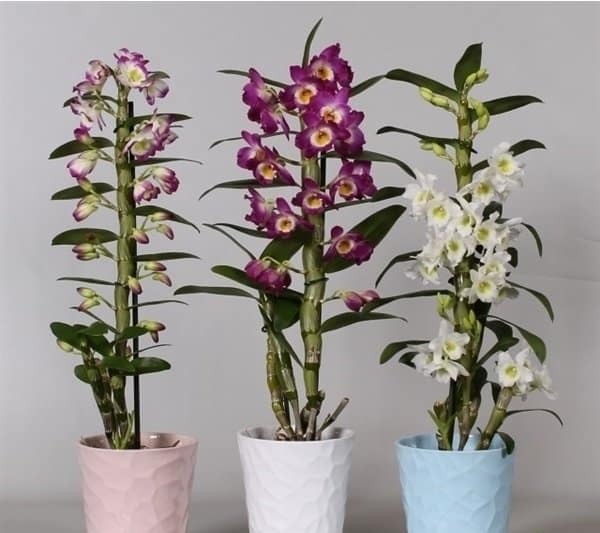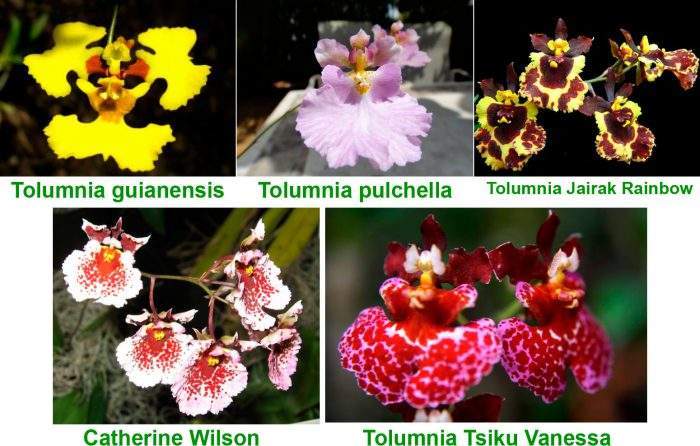Optimal conditions of detention
Important! The first condition for good growth and flowering is bright lighting without direct sunlight.
In second place is air humidity. Dry air is destructive for gentle tropical exotic. During the heating period, you need a humidifier or a tray with wet pebbles, in no case touching the roots.
A viable plant can survive in temperatures ranging from 3̊ to 42̊ C.
Dendrobium will become a decoration and pride of the house only in optimal conditions for it. Life Cycle Period:
- To build up green mass:
- Day - 24̊С-27̊С;
- Night - Not higher than 22̊С-24̊С.
- To stimulate flowering:
- Day - 24̊С-25̊С;
- Night - 24̊-25̊, optimally 18̊-20̊.
The difference in day and night temperatures is a must for those who want to have a healthy plant in flowers. Do not go beyond the optimal temperature range of 16̊C-30̊C.
Transplant and care after purchase in the store
Having bought a blooming orchid, do not rush to transplant it. Transplantation is possible only after the end of flowering and with sufficient grounds, otherwise it will only harm the plant.
Watering and feeding
In the warm season, during the period of active plant growth, more frequent watering is needed than in winter and autumn.
The soil should be allowed to dry completely between waterings, and the frequency of watering should be selected empirically for each specific room.
The orchid should be well watered, otherwise it will die.
On average, from mid-spring to early autumn, it is enough to water once or twice a week, and during the rest of the year no more than once every two weeks.
The immersion method is very good when the container with the plant is completely immersed in water. If you do not drain the water from the pan, the roots can suffer from rot.
If the plant is green and fresh, the roots are clean and without rot, then the watering is optimal.
We use special fertilizers for orchids. The main feature of such solutions is that they do not settle on the ground, do not accumulate and do not harm the roots.
| Fertilizer type: | Phase of the year: | Period: |
| Nitric. | Growth of green mass. | With the beginning of active growth, approximately March. Fertilizer is added to water for irrigation, every other time. |
| Potassium phosphorus. | Formation of buds. | When the buds appear. |
Advice! From the moment the buds open, active fertilization should be stopped until next spring. This will take much longer to bloom.
How to stimulate flowering?
Dendrobium Nobile lives in accordance with the annual development cycle, so stimulation will be effective in the spring, immediately after phases of active growth:
- Phytolamp illumination on cloudy days and supplementary illumination for an additional 4-5 hours every day;
- Spraying with succinic acid according to the instructions;
- Apply cytokinin paste to visible kidneys in the sinuses.
Prevention of diseases and pests
- Quarantine. The new plant should be kept separately for a month. This is a sufficient time for latent problems to appear - pests or diseases;
- Pests can move to the windowsill from the street with an open window;
- Draft. It is necessary to place the pot away from the open window and to protect the roots and leaves from hypothermia in the wind, there is a danger of decay;
- Cold windowsill. In nature, cold is unfamiliar to orchids, the roots must be insulated with a stand for the winter;
- Adequate time between waterings. The soil should dry out completely, this is the prevention of rot on the root system;
- The exact amount of fertilizer according to the instructions. An overfed plant may stop blooming and the leaves may crack.From a "hungry" flower, you will not wait for a lush bloom.
Further care
Dendrobium orchid vegetation is badly affected by dry air, lack of lighting and excess moisture. Dendrobium orchids have many types, and each of them has its own preferences, but there are also common requests. Dendrobium prefers bright, diffused light without direct sunlight. Does not tolerate drafts.
Lighting
If an orchid has white or pale pink flowers, it means that they can withstand the lack of lighting much more easily. They can be left on the northeastern windowsills with additional lighting. If the flowers are bright red, yellow, pink, then such orchids are best placed on the windows of the southeast and southwest sides.
Watering
Watering can be done by the surface method or by immersion. Watering should be done with boiled water. The water temperature should be slightly above room temperature. From April to September, it is recommended to combine watering with top dressing. But you need to feed not every watering, but after about 2-3 waterings.
Important! Water should not come into contact with peduncles, flowers, leaf axils and young bulbs. If this condition is not observed, the plant can rot.
If liquid gets in, it must be blotted with a napkin.
Humidity
At higher temperatures, when the water evaporates faster, a small part of the necessary moisture reaches the roots. At this time, it is imperative to regulate the humidity of the air. You can put the pots on a tray with water and pebbles or wet moss. Also improve the spraying situation. It is advisable to spray in the early morning or evening so that drops of moisture do not lead to burns.
Fertilizers
You need to start feeding dendrobium in April and finish in September. Fertilizer can be added to the water that the flower is watered with. Or, half an hour after watering, spray it with it, or place the pot in a solution.
Make the fertilizer concentration 2 times less than what is written on the package.
Along with the above methods of reproduction of orchids, another option is available to representatives of the sympoidal species - propagation by roots.
Observing all the conditions for the reproduction and cultivation of the dendrobium orchid, you can get the most beautiful plants. That will allow this flower to delight the eye for many years.
Dendrobium care at home. In detail
Caring for a dendrobium orchid at home is not difficult, but still it has a number of features.
Dendrobium orchid bloom
 Dendrobium blooms after a short period of rest. Peduncles appear only on 2-3 year old bulbs. The total flowering period is 2-3 weeks. The number of colors directly depends on the temperature and light intensity during the dormant period.
Dendrobium blooms after a short period of rest. Peduncles appear only on 2-3 year old bulbs. The total flowering period is 2-3 weeks. The number of colors directly depends on the temperature and light intensity during the dormant period.
After flowering, old bulbs are not cut off. They should dry naturally. In this case, the nutrients accumulated in them will be absorbed by the remaining shoots.
New varieties of dendrobiums can bloom without a dormant period. The process of maturation and the formation of bulbs in them continues in the winter. The main thing is to provide the plant with the necessary lighting.
Temperature regime
Home orchid dendrobium grows well at normal room temperature... At the same time, it is desirable for her to provide a difference between day and night temperatures. The lowered temperature at night promotes the ripening of shoots and the establishment of flower buds.
Spraying
All modern varieties of dendrobiums are perfectly adapted to the usual level of humidity in living quarters. Therefore, spraying with them, as a rule, is not required.
Lighting
The dendrobium orchid plant at home requires intense lighting. Varieties with dark-colored flowers are especially demanding to the level of illumination. In autumn and winter, southern windows are best suited for dendrobium.
For the summer, the plant must be rearranged to the east or west side.
Watering dendrobium orchids
 Watering the dendrobium is carried out by immersion. To do this, place the pot in a cup of warm water for 15-20 minutes. Irrigation water must be defended or filtered before use. Once a month, watering is replaced with a warm shower.
Watering the dendrobium is carried out by immersion. To do this, place the pot in a cup of warm water for 15-20 minutes. Irrigation water must be defended or filtered before use. Once a month, watering is replaced with a warm shower.
The frequency of watering depends on the ambient temperature. In summer, the plant is watered much more often, in winter it is very rare. If the orchid is kept in the cold, watering is stopped altogether. In case of severe wrinkling, the bulb is simply sprayed with warm water. In general, the potting medium should dry out completely between waterings.
Dendrobium orchid pot
For young orchids, choose small transparent pots made of plastic. So that the plants do not turned over, put several stones on the bottom. For planting large, overgrown specimens, heavy, ceramic flowerpots are suitable.
Priming
The dendrobium orchid is grown at home on a substrate of bark and moss. The soil mixture is prepared at the rate of 1 part of crushed moss to 1 part of bark, plus a small amount of pieces of charcoal and peat. Before planting, the substrate must be spilled with boiling water.
Top dressing and fertilization
To feed the dendrobium, special fertilizers for orchids are used. They are introduced in the form of solutions at every 3 or 4 watering. Foliar spraying can also be used if necessary. During the rest period, fertilizers are not used.
Dendrobium orchid transplant
 Dendrobium orchid transplantation is carried out after the peduncles have dried up at the moment when the plant begins to grow intensively. The need for transplantation is determined by the state of the substrate. If it has decomposed, salted, or mold has appeared on its surface, the plant must be replanted.
Dendrobium orchid transplantation is carried out after the peduncles have dried up at the moment when the plant begins to grow intensively. The need for transplantation is determined by the state of the substrate. If it has decomposed, salted, or mold has appeared on its surface, the plant must be replanted.
During transplantation, attention is paid to the condition of the root system. All rotten and blackened root areas must be cut out to healthy tissue
The resulting cut sites must be sprinkled with charcoal powder or cinnamon. In some cases, the plant may even need a smaller pot after root treatment.
After transplanting, the plant is not watered for a week.
Pruning
Dendrobium does not need special pruning. Completely dried stems and leaves are removed from the plant as needed.
Dormant period
For the mass establishment of flower buds, the plant needs a dormant period. To do this, after the end of growth, dendrobium is transferred to dry conditions at night temperatures no higher than + 15-18 °. In this case, the plant must be well lit. In such conditions, the flower is kept for at least 1.5 months.
During this period, the dendrobium is not watered. To prevent bulbs shrinking, shoots are sprayed 1-2 times a week with cool, previously settled water.
2 Transplant and reproduction
Dendrobium transplant is carried out every 2-3 years. The procedure should be carried out after the end of flowering (usually in the spring). Before proceeding with the transplant, you need to make sure that the plant really needs it. For example, his roots begin to deteriorate (or they have grown too much and cannot fit into the pot), the substrate is too oxidized and needs to be replaced.
To transplant a plant, you must:
1. Choose a pot. It should be small, as the roots of the plant prefer tightness.
2. Prepare the substrate. Can be purchased at the flower shop. It is necessary to choose the one that is intended for epiphytes.
3. Pour crushed pieces of bark, drainage (expanded clay, pebbles, stones, gravel) onto the bottom of the pot.
4. Spread out a small amount of soil.
5. Carefully remove the flower from the old container, transfer to a new one.
6. Spread the roots
This must be done carefully as they are fragile.
7. Cover empty space with soil
Tamp it lightly.
8. Place sphagnum moss on top. It retains moisture well.
9. Water a little.Place in a suitable place.
The next watering is performed only after a week.
Reproduction of an orchid of the genus Dendrobium is carried out in 3 ways. When grafting should be:
- to separate the faded pseudobulbs from the main plant at ground level;
- cut cuttings up to 10 cm long;
- process the places of the cuts with garden pitch;
- place 1-2 cuttings in zip bags with moistened sphagnum moss inside;
- create greenhouse conditions by providing bright diffused light, a temperature of about 25 ° C, ventilation, moss moss every day.
After about 2 weeks, roots form on the cuttings.
You can propagate dendrobiums by dividing the shrub. The procedure must be carried out when transplanting a plant... Should:
- Remove the large bush from the container. Clean from soil.
- Untangle the roots. If necessary, cut them with a sharp, clean knife.
- Treat the cut sites with activated charcoal or wood ash (powder).
- Place the individual parts in containers. Make sure there are enough roots and about 2-3 pseudobulbs.

Reproduction is carried out by seating cakes (children). They are separated from the main flower together with the stem. Use only a disinfected sharp knife. The roots of the baby should be more than 3 cm. The length of the process cannot be less than 4 cm.
The usual soil for dendrobiums is soaked for a day to make it softer. The sprouts are placed in a jar of warm water for 10 minutes, then planted in a small pot. It is recommended to place 2-3 pieces in one container.
Possible problems
Very often you can face such problems as:
- lack of flowering;
- falling leaves;
- rotting roots;
- yellow leaves.
All this happens due to improper watering, or not enough good lighting.
Reference. On average, dendrobium blooms from two to three months, but these periods depend on the individual plant variety.
Sometimes pests can be encountered. Usually, dendrobium is susceptible to attack:
- tick;
- mealybug;
- aphids;
- scabbards.
Quite often, parasites infect dendrobium even in the store. Only chemical treatment of dendrobium will help get rid of pests. Therefore, when purchasing a flower, you should carefully examine it for the presence of pests and fungi. And also check if the roots are rotting.
Dendrobium is a very beautiful plant and, with proper care, will undoubtedly delight you with exquisite flowers. One has only to gently adapt this tropical flower to indoor living conditions.
When leaving, be sure to pay attention to:
- watering;
- light;
- the temperature of the plant.
Secrets of growing dendrobium orchids
There are techniques and methods to optimize the process of growing dendrobium in your home. Knowing the subtleties of these types of flowers, you can achieve high levels of aesthetics, provide the plant with conditions, ensure abundant and long flowering.

One watering option is to place the pot in the water
How to properly water dendrobium
Orchids are quite hygrophilous. Watering can be done either in the classical way - pouring moisture into the pot, or submerged - occasionally placing the root of the plant in a container with water. This is especially useful for growing in baskets or blocks. The signal for the next watering is the dried out topsoil. In winter, watering is significantly reduced, only occasionally moisturizing the substrate in small portions. Fertilizers are added to the water in summer. Be careful: do not allow water to enter the upper parts of the plant, so that it does not rot. The water should always be slightly lukewarm and soft in composition. If there is no filter, boil water for irrigation.
Top dressing during the growing season
Fertilizing the dendrobium orchid is necessary during the period of active growth. This is the period from the end of flowering until the onset of a state of dormancy. In Russia, it chronologically coincides with the warm season - late spring, summer and early autumn.It was at this time that dendrobium actively grows with a green mass. In this matter, he needs to be helped by adding nutrients.

Liquid fertilizers for orchids
A special group of fertilizers for orchids is intended for application to leaves by spraying. It can be found in stores under the name Orchid Leaf Care. Most of these formulations contain urea.
Another group is intended for absorption by the root system and assimilation by the plant "naturally". They are sold in liquid form and have common names like Fytopan, Orchid Food and others.
For top dressing, mix the liquid in a 1: 1 ratio with water, pour into the pot at the end of watering so as not to burn the rhizomes. Occasional fertilization - every 3 - 4 waterings.
How to achieve flowering dendrobium
If you want to achieve flowering of your orchid, then you need to follow several important rules:
- provide a sufficient level of illumination;
- together with the light, the orchid should receive a sufficient flow of air, that is, it should stand in the summer and autumn either in a draft or in the open air;
- do not overfeed or overmoisten the dendrobium;
- after the end of the active growing season, place future buds in the cold, up to 12 degrees.

In appropriate conditions, denbrobium will delight with flowering
The dendrobium has a characteristic feature: this orchid will transform the buds into babies without decreasing the temperature, that is, it will continue to grow in green mass. Thus, lowering the temperature, especially at night, is key to initiating the flowering process.
Noble (nobile)

This variety can be found in almost all true lovers of orchids. Nobile is a picky plant native to the Himalayas, where the noble orchid adorns the mountain slopes with its flowering.
There are more than 80 varieties. The color of the flowers is white at the base, lilac along the edging. The new petals of the plant appear from the roots and form a sprout that lives up to four years. In the photo of dendrobium nobile, located above, you can clearly see the beautiful flowers.
Nobile is a rather tall orchid, reaching 90 cm. Stems at the beginning of life are slender, erect, fleshy, but in old age they can not only bend over, but also lie down. Peduncles are formed on the shoots of the second year of life, 3-4 flowers bloom on one, each of which can reach 10 cm in diameter. The aroma is pleasant.
Sometimes this orchid misses flowering even with proper care. This should not bother: the plant is just resting, and next season it will delight you with abundant flowering, large flowers will bloom on shoots of any age (except for one-year-olds). Flowers bloom from January to May.
Possible maintenance problems
Despite its unpretentiousness in natural conditions, the dendrobium orchid is quite demanding on the growing conditions. The problem most often lies in the fact that in Russian conditions it is quite difficult to obtain conditions South-East Asia... Since not everyone has the opportunity to create a separate temperature and humidity regime for a flower with the required dosage of solar insolation, when growing, there are often violations in the development of an orchid. The table lists possible problems, their causes, and options for elimination.

Shrinking leaf tips - a mess
Table # 1. Dendrobium Orchid: Growing Problems
| Problem | Cause | Solution options |
|---|---|---|
| Shrinkage and wilting of the pseudobulb during the growing season | The flower lacks moisture, insufficient watering | Increase watering, ensure sufficient air humidity |
| Blooming flowers last no more than two weeks | Temperature too high for the flowering period | Move the flower to a cooler room. |
| The new orchid has gray and soft roots the leaves turn yellow and fall off | In a flower shop, an orchid was filled with water | Treatment with a fungicidal preparation will help, bringing the watering regime to normal |
| The plant refuses to bloom for more than a year, the forming stems are long and thin | The orchid exists in low light conditions. | If it is not possible to rearrange the orchid pot on the sunny side, then you will have to add artificial lighting |
| Flowers form normally, but soon dry out and fall off. The same situation with the upper leaves | 1) High room temperature | Lower the temperature |
| 2) The plant may be attacked by pests | Treat the orchid with appropriate pest control compounds | |
| The roots turned brown | Root rotting as a result of over-watering, planting in unsterilized soil mixture | Reduce watering. In the absence of results, transplant the plants into a suitable soil |
| Leaf color change to pale green, appearance of a marbled pattern | Nutrients are deficient in metals - magnesium and iron | Feed the orchid with fertilizer with the right substances |
| The tips of the leaves dry up, turn brown | Insufficient air humidity, soil salinization is also possible | Transfer to a suitable soil mixture, use of a humidifier |
| Too short pseudobulbs | Excessive lighting. Happens if the orchid is on the west or south side in summer | Shade the plant, make the light diffuse, reduce its intensity |
| Leaf shedding regardless of the season | The plant has become a haven for pests | Treat the orchid with appropriate preparations, sterilize the soil during transplantation |

Pest traces
As can be seen from the table, the main parameters disturbed during cultivation are the level of illumination, the amount of moisture and the balance of fertilizers. Animal and plant pests can also harm the dendrobium orchid.
Optimal conditions of detention
Dendrobium orchid is easy to ruin if you violate the rules of care, for example, organize the wrong irrigation system or insufficient moisture. In general, such a variety requires conditions that are unusual for other orchids.

Lighting
High-quality lighting is very important for the dendrobium orchid, but it should not burn out in summer from an excess of ultraviolet radiation. In winter, in the case when the plant does not have enough light, the shoots can bend and not form the required number of buds
In such cases, it is imperative to use additional artificial lighting, allowing you to stretch the daylight hours up to 12 hours. Both special phytolamps and ordinary fluorescent bulbs are suitable for this purpose. Also, if possible, move the pots to the sills of south-facing windows. In the spring and summer, orchids will thrive on east and west windows.

Temperature
Since most dendrobium orchids enter the resting phase in winter, temperatures in cold and warm seasons differ for them. In summer, the flower is kept at a temperature of 22 to 28 degrees, and in winter - from 17 to 20 degrees Celsius. During active growth, the temperature can be 25 degrees during the day and 20 degrees at night. In the fall, rates drop to 20 degrees during the day and 10 degrees at night. It is worth mentioning that the orchid simply will not survive the heat above 30 degrees Celsius.

Temperature determines the state of the orchid only when the lighting is at the optimum level. If the flower is poorly lit, then more degrees will not play a special role. It should be remembered that too high a temperature leads to an acceleration of the evaporation process of the liquid, which means that it is necessary to additionally increase the humidity. This is done by regular spraying or by installing pallets with wet moss or water with pebbles.
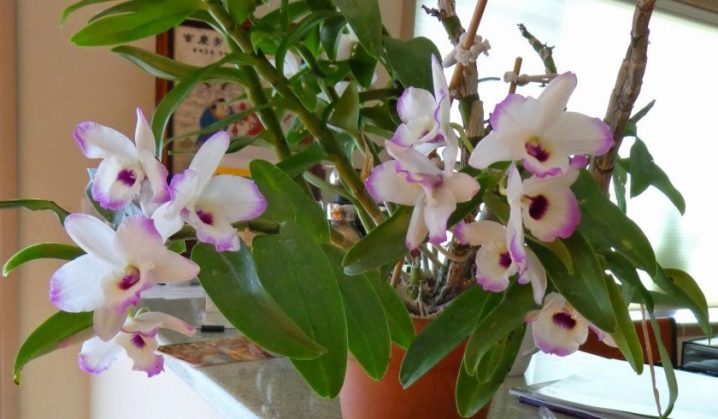
Humidity
Dendrobium needs high humidity. To achieve it, the flowers are sprayed with settled water or are placed on trays with moistened expanded clay or pebbles... Using a commercially available humidifier will also work.Spraying is carried out only at a time when direct sunlight does not fall on the orchid, that is, in the early morning or late evening. Otherwise, it will be easy to provoke a burn resulting from the refraction of light in the liquid droplets.

Views
Currently, more than a thousand species of dendrobium orchids are known. Each of them has its own characteristics, and hence the care requirements. A variety of dendrobium "Nobile Apollo", which is also called noble, belongs to the decorative species. Quite fleshy and dense, the stems are covered with glossy skin and reach approximately 1.5 meters in height. Flowering begins in the second year after planting and happens several times every 12 months.


White flowers reach ten centimeters in diameter and are characterized by the presence of elongated petals with sharp tips. This type is considered quite unpretentious and feels good at a temperature of 15 degrees Celsius. Throughout the entire life cycle, the orchid should be well lit, but with the help of diffused light. In winter, the required level is achieved using artificial lighting, for example, phytolamps. Planting is carried out in a soil mixture created from peat, charcoal, and pieces of moss.


In the list of names of popular varieties is the dendrobium orchid "Moniliform". It grows slightly - the height reaches only 20 centimeters. In Russia, such an orchid is considered rare and quite expensive, but very beautiful. Flowers attract gardeners with a combination of white and purple colors, as well as a delicious aroma. With proper care, an orchid can bloom for 12 months.


"Moniliform" can withstand direct exposure to ultraviolet radiation without consequences, moreover, it is even recommended to be under the sun for a couple of hours a day. The plant does not have any special requirements for air humidity. It is better to take a special substrate suitable for any type of orchid and characterized by good permeability to both air and moisture. It is better to irrigate the flower by soaking a couple of times a week.


The height of the Kinga dendrobium ranges from 30 to 55 centimeters. Each peduncle forms about 7 buds, which, when open, reach three centimeters in diameter. Such flowers smell like vanilla. "Kinga" blooms in early spring and pleases its owners with an excellent appearance and aroma throughout the month. In winter, the plant experiences a dormant time, during which care is required to a minimum.


Dendrobium Berry Oda is a hybrid of the Kinga orchid. The color of the flowers can be either snow-white with pinkish tints, or deep crimson. The flowering period lasts from February to almost June. Sometimes there is repeated flowering in the fall. "Berry Oda" is an unpretentious plant that feels great in an apartment. The height of the bush reaches 40 centimeters. Orchid leaves are covered with glossy skin. The tip of each long leaf ends with a dark green pointed end. A fairly short peduncle gives 4 or 6 flowers of an amazing purple hue.


Dendrobium orchid "Lindley" forms a low rounded pseudobulb, shaped like oval and, in fact, is a stem. Peduncles grow long and downward. The flowers grow in a beautiful golden hue and with a pleasant scent. The leaf appears large and leathery. Dendrobium can dissolve buds both once and a couple of times a year. Dendrobium "Sa-nuk" is a hybrid variety developed in Thailand. Its flowers are small in size, painted in a pastel yellow shade. Flowering is profuse.
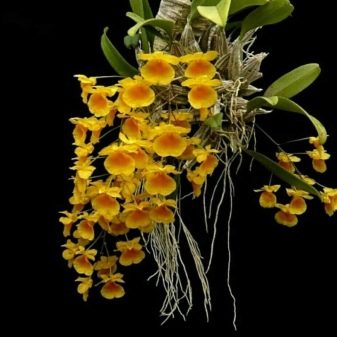

Dendrobium orchid "Hibiki" grows slowly, but for many weeks it pleases gardeners with exquisite two-color flowers: with pink petals and an orange-colored lip.The height of the flower is 20 centimeters. The leaves have a leathery surface of a light green hue. A small peduncle forms from 7 to 15 buds. Flowering occurs once a year and lasts up to 5 months.

